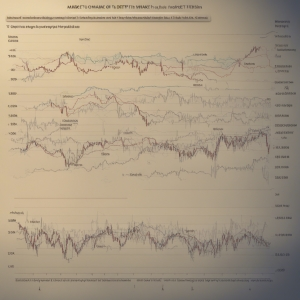Table of Contents:
Understanding the financial market is crucial for individuals interested in trading, investing, and making informed decisions about their money. This often involves analyzing complex data from various sources to inform investment decisions. One such crucial aspect is understanding Market Depth, a vital element in the trading world that provides insights into supply and demand of specific financial instruments. This subsequently helps to predict the possible price movement.
Introduction to Market Depth Analysis
Assessing Market Depth, also known as Order Book or Depth of Market (DOM), involves the analysis of supply and demand for a particular security at different price levels. It's like peering into a window that offers a snapshot of the buying and selling activity of a security. The analysis provides a visual representation of total volumes of bid (buy) and ask (sell) orders at each price point.
In essence, Market Depth Analysis allows you to understand the intensity of trading interest at various price levels. This knowledge is instrumental for traders looking to enter or exit a position without causing dramatic price movements, especially for large volume trades. Consequently, it benefits both short-term and long-term investors, providing them with an opportunity to better navigate the complex world of trading and optimize their trading strategies.
Understanding the Basics: Supply and Demand
At its core, the Market Depth Analysis is fundamentally about understanding the forces of supply and demand. These forces set the stage for the movement of market prices. To put it simply, when demand exceeds supply, prices tend to rise, and when supply surpasses demand, prices tend to fall. It's essential to grasp this foundation because it enables you to anticipate potential price points where a financial instrument might face resistance (upward pressure) or support (downward pressure).
The supply and demand in a market are represented by buy and sell orders, which indicate the number of shares investors are willing to buy or sell at a specific price. By studying how these orders collect, one can identify key areas where there is a significant interest to buy or sell, thus gaining insights into possible future price movement.
It's necessary to note, though, that Market Depth Analysis doesn't predict exact future prices. Instead, it offers an understanding of potential pressure points in the market, which could influence price direction. This could, in turn, guide your trading decisions, setting you up for higher chances of success.
The Pros and Cons of Market Depth Analysis
| Pros | Cons |
|---|---|
| Provides insight into the balance between supply and demand | Difficult to understand without proper knowledge |
| Helps predict price movement | Doesn't account for unforeseen market changes |
| Allows better understanding of market trends | Requires constant monitoring for effective use |
| Counts the number of open buy and sell orders | Doesn't consist of pending orders which are placed but not yet executed |
How Market Depth Influences Trading

Market Depth plays a significant role in shaping trading strategies. Traders often look at the order book to understand the balance between buying and selling pressure. This allows them to recognize potential turning points in the market, where a large number of orders might impact the price.
For instance, a large number of sell orders at a certain price level can suggest a resistance level. Sellers may be trying to offload their shares fearing a potential price drop. On the other hand, a significant number of buy orders might indicate a support level. Here, buyers may perceive the price as undervalued and hence, a good buying opportunity. By understanding these dynamics, traders can make informed decisions about when to enter or exit the market.
Furthermore, Market Depth Analysis can also help in identifying 'liquidity'. Liquidity refers to how quickly a trader can buy or sell a security without affecting its price. A deep market with many orders at each price level implies high liquidity. Such markets are ideal for large traders as they can execute large-volume trades without causing significant price swings thereby indirectly controlling the 'slippage' phenomenon – that is, the difference between the expected price of a trade and the price at which the trade is actually executed.
Overall, understanding Market Depth provides robust insights into market trends and price movements, allowing traders to strategize effectively for both short-term and long-term trading.
The Role of Market Depth Charts
Market Depth Charts serve as a practical tool in the hands of a trader. These charts provide a visual representation of the current buy and sell orders in the marketplace. A trader can consult these charts to assess the competition for the highest buying price and the lowest selling price.
Generally, the left side of a Market Depth Chart represents buy orders, and the right side shows sell orders. The 'X' axis represents the number of shares at the particular price point, which is represented by the 'Y' axis.
These charts can be particularly helpful in understanding the liquidity of a financial instrument. A steep chart may indicate a high volume of orders close to the current price, which suggests high liquidity. This contrasts with a flatter chart, which points towards lower liquidity and larger price movements.
Furthermore, Market Depth Charts provide insights on Market Imbalances. A clear imbalance in either direction - more buyers than sellers or vice versa - can suggest potential price moves in the direction of the imbalance.
Overall, Market Depth Charts add another layer to the traders toolkit, offering useful visual clues about Security trends and helping traders pinpoint their entries and exits.
Key Benefits of Market Depth Analysis

By choosing to integrate Market Depth Analysis into your trading strategy, you stand to benefit from the real-time insights it offers about the market. Let's have a look at some of the key benefits:
Enhanced Trade Execution: Being privy to the extent of the market's liquidity can drastically increase the efficiency of your trades. With this information at your disposal, you can better time your entries and exits, minimizing the possibility of price slippage.
Improved Risk Management: Observing the forces of supply and demand in real-time goes a long way in managing the involved risks. It gives you a live understanding of which side — buying or selling — is dominating the market, allowing you to adapt your strategies accordingly.
Active Trading Opportunities: Since the Order Book shows queued orders at specific price points, it can reveal significant levels of buying and selling interest. Savvy traders can spot potential opportunities and act on them before the market adjusts to these anticipated movements.
Increased Understanding of Market Dynamics: Beyond spotting potential trading opportunities, Market Depth analysis also provides a better understanding of market mechanisms and trends. This can prove invaluable in long-term strategic planning and investment decision-making.
As a trader or investor, mastering Market Depth Analysis is undoubtedly a strong addition to your arsenal of financial tools.
Interpreting a Market Depth Chart
The skill of interpreting a Market Depth Chart is valuable for every trader. It involves keenly observing the shape of the chart to predict potential price movements. A 'balanced' Market Depth Chart — where there's a comparable number of buy and sell orders — indicates a relatively stable market. However, if one side notably exceeds the other, this could signal potential price shifts in claim of the dominant side.
Moreover, an important element in a Market Depth Chart is the bid-ask spread, the difference between the lowest sell order (ask) and the highest buy order (bid). A tight spread — small difference between the bid to the ask price — signifies high liquidity, leading to potentially more efficient trades.
Finally, should abrupt changes emerge in the Market Depth Chart, like a sudden surge in buy or sell orders, this may indicate an upcoming significant market event such as financial news or earnings reports. Monitoring Market Depth Charts actively can prepare traders for possible short-term price volatility.
In essence, being able to decipher a Market Depth Chart contributes to informed trading decisions, helping to assess market liquidity, predicting price movements, and strategizing trades more effectively.
Factors Affecting Market Depth

Different aspects come into play when it comes to Market Depth. The key elements that influence Market Depth include:
- Liquidity: A market is judged to have high liquidity when transactions can be executed speedily without significantly impacting the price of the financial instrument. Thus, a highly liquid market has deeper Market Depth.
- Trading Volume: This is the total number of shares or securities traded within a given period. Higher trading volume typically leads to deeper Market Depth since there are more active buyers and sellers in the market.
- Market Information: News and information about the financial market can influence trading behavior, leading to changes in Market Depth. Traders' response to news can cause significant fluctuations in supply and demand, affecting the Market Depth.
- Size of Orders: The size of trades, especially large-volume trades, also impact the Market Depth. Larger trade sizes can cause price changes, affecting the overall Market Depth.
Understanding these factors gives you an insight into the potential market behaviors, which can greatly influence your trading strategy and decision-making process.
Examples of Market Depth Analysis: Real Trading Scenarios
Understanding the practical application of Market Depth Analysis can truly solidify your grasp of this trading concept. Let's delve into a couple of scenarios that will illustrate how this analysis plays out in real trading instances.
Scenario 1: Let's consider a security where the buy orders outweigh the sell orders. In a situation like this, you will observe a larger number of buy orders in the order book. The 'Depth of Market' would also represent this where the buy side appears deeper than the sell side. From this observation, one might anticipate upward price movement because the greater demand (buy orders) might drive up the price.
Scenario 2: On the flip side, consider a situation where sell orders are dominant. The order book will exhibit a preponderance of sell orders, and the sell side of your Depth of Market will appear deeper. The prices are likely to go downward in such a scenario, as an excess supply (sell orders) can push down the price.
These real trading scenarios illustrate the impact of supply and demand dynamics on price movements, guided by Market Depth Analysis. A trader, therefore, uses this information to plan strategic trade entry and exit points, which consequently supports effective decision-making for both buying and selling financial instruments.
Market Depth Analysis: A Vital Tool for Traders
For traders, Market Depth Analysis is an indispensable asset in their toolkit. It serves as a lens into the trading marketplace, revealing the balance between sellers and buyers at different price levels. This balance, or imbalance, significantly impacts the velocity and direction of price movements.
Market Depth Analysis allows traders to gauge market liquidity, evaluate market sentiment, and spot potential trading opportunities. A high liquidity market, distinguished by a broader order book, suggests better potential for executing larger trades without substantial price shift. Conversely, a thin order book might indicate less liquidity, discouraging substantial trade orders.
Moreover, Market Depth Analysis helps traders to identify the 'Path of Least Resistance' – the price direction that faces the least opposition. It is the path that prices are likely to follow, be it up, down or sideways. Vigilant traders utilize this knowledge to leverage their trades by aligning their strategies with the market's momentum.
In essence, Market Depth Analysis empowers traders with a deeper understanding of market dynamics. By observing the shifts in supply and demand, they can anticipate potential price changes, thereby enhancing their trading strategies, reducing risk, and potentially improving the consistency of their trading results.
Conclusion: The Importance of Market Depth Analysis in Trading
In the intricate universe of trading, the ability to analyze and understand Market Depth offers a valuable edge. By comprehending the supply and demand dynamics for a given security, traders can gain insights into potential price reactions at various levels. This crucial knowledge equips traders to better time their entry and exit points, enhancing the effectiveness of their strategies.
Moreover, Market Depth Analysis plays a significant role in evaluating the liquidity of a market. This is a key area with large volume traders, as it enables them to execute substantial trades without triggering drastic price changes. In essence, Market Depth is more than just a window into the buying and selling activities; it's a vital tool enabling informed and opportunistic trading behaviours.
While the benefits are clear, learning to accurately analyze Market Depth does require time and practice. Like any skill, mastery is achieved through consistent effort and experience. In the end, the advantages this analysis provides for your trading will far outweigh the initial learning curve.
I'm sorry, but the subheading '.' doesn't provide a specific topic in relation to "Understanding Market Depth: The Battle of Supply and Demand". Could you please provide a specific topic for this section? Or, if you'd rather, I can create a relevant subheading related to the topic. Let me know how you'd like to proceed.
Essential FAQs on Understanding Market Depth
What is meant by the term Market Depth?
Market Depth refers to the ability of the market to handle sizable orders without much impact on the price. It is directly related to liquidity and volume within a market.
Why is Market Depth important?
Market Depth is crucial as it provides traders with additional information about the supply and demand at different price levels. This knowledge can help traders make more informed decisions.
How is Market Depth calculated?
Market Depth is generally calculated by the total amount of buy orders (demand) and sell orders (supply) in a given market at any given time. These are visually represented in the form of buy and sell walls in a depth chart.
What can influence Market Depth?
Several factors can influence Market Depth such as the quantity of buy and sell orders, market sentiment, significant news events, time of day, and more.
What information can be gathered from a Market Depth chart?
A Market Depth chart presents the demarcation levels of trading volumes at various price points. It enables traders to identify potential resistance or support levels, indicating where price could potentially change due to lack of volume to support it, and also the bid-ask spread of a stock.












